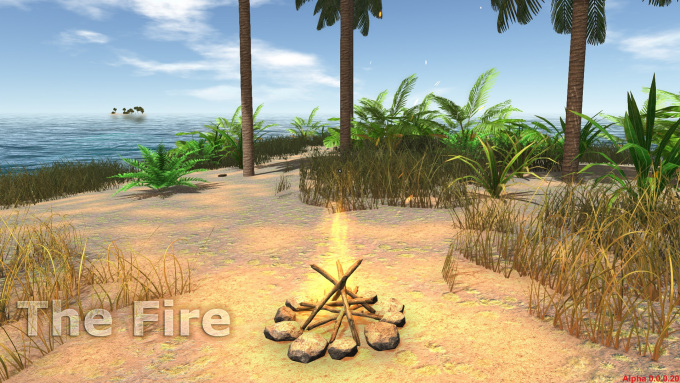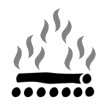
The Fire also has great importance in our game. The player must learn how to use it effectively, because in some situations his life can depend on it: whether he can ignite his last fire or not. It may be useful to stockpile some dry wood for emergency use.
All burnable materials (wood, coconut fiber, palm fronds, ...) in the game have their 'Wet' property. It indicates the wetness of the given material in four stages: dry, almost dry, wet, soaked.
The calculation of the 'wet' property is nearly the same as in the case of our players 'RealFeel' engine. The drying up is faster at higher environment temperatures, on direct sunlight and in the wind. To the contrary, it is slower at lower temperatures, in shade and in windchill. The wetness growth is faster directly in the ocean. Placed on the open, it is depending also from the intensity of the rain. The rain is not affecting for example the chopped wood, when it is stocked under some buildings roof or under the trees fronds.
The 'wet' property of different burnable materials is reacting differently to the weather elements. It is based on the type of the material and its size. For example, the thinner wood stick is reacting faster to the environment changes compared to thicker log. The actually chopped wood is wet. The collected driftwood from the ocean is totally soaked. To have it dry the fastest way, it is needed to cut it to smallest sticks and have it placed on direct sunlight. The wood sticks found on the island can be variably wet or dry based on the previous weather effects.
Campfire

The quality of the fire depends a lot on the used woods 'wet' property. The wet wood degrades the fire intensity and increases the smoke density. During the burning the wood dries up and the fire gets higher quality. The player must use as dry wood as he can to ensure highest fire intensity.
The fire can be ignited when at least one dry wood is used. When the fireplace is on the open and it is raining, the wood gets wet and the fire can be extinguished. When the player is forced to use the same fireplace (due to lack of materials), he must wait till the wood dries up and he can ignite the fire again. The wind also has effect on the fire. In strong wind the fire cannot be ignited at all. When the fire is burning already, strong wind is accelerating the burning.
Smoker

In case of Smoker the player needs not only small flames, but also dense and strong smoke. It is advisable to use as wet wood as possible. The burning process will be slow, with small flames, but the smoke will be good enough to make the meal long lasting. The denser the smoke, the faster the smoking process will be.
It is advisable to place the smoker to a windchill to ensure the smoke is not blown away and the burning process is not accelerated. When the wind is blowing mainly from one direction (on some latitudes) placing the Smoker next to some big rock is enough, but when the wind direction is changing rapidly, it is a good idea to build a smoking cabin and place the smoker inside it.
We have uploaded a short demonstration video to our channel on YouTube, check it out!




